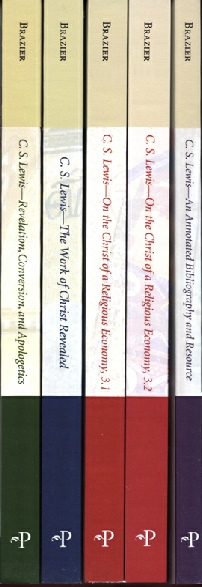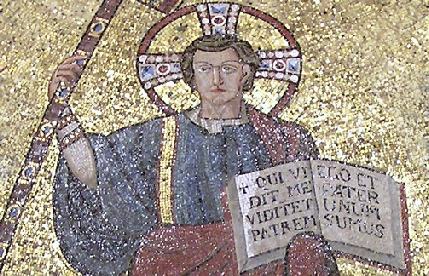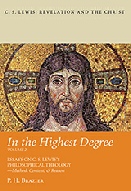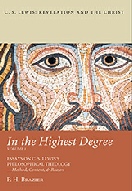

Revelation
The Christ





C. S. Lewis: Revelation and the Christ . . .
is an in-depth study of the theology and philosophy of C.S. Lewis. This is written for professional theologians/students, but also inquiring Christians who have read Lewis’s works.
As a series it consists of five books :
Book One
C.S. Lewis–Revelation, Conversion
and Apologetics
Book Two
C.S. Lewis–The Work of Christ, Revealed
Book Three
C.S. Lewis–On The Christ of a Religious Economy
Book Three will be published in two parts
C.S Lewis–On The Christ of a Religious Economy.
I. Creation and Sub-Creation
C.S Lewis–On The Christ of a Religious Economy.
II. Knowing Salvation
An in-depth bibliography, plus an introductory essay on Christology as the study of Christ, and a glossary, completes the series :
Book Four
C.S. Lewis–An Annotated
Bibliography and Resource
Click on the book titles above to find out more.
Many of the images on this website are assumed to be in the public domain. If you own an image, please contact us to request removal or copyright credit.


Details about
the Series,
and Comments–
The Series, Endorsements,
and Comments
Click on the above link, or on the books to the right, to find out more about the structure of the series, the contents generally of the five books, and comments and endorsements on the books already published
Jesus Christ is central to the Life and work of C. S. Lewis.
As a young atheist, Lewis gradually became ‘religious’, eventually being brought face-to-face with the reality of who and what Christ was, and is, by his friends J.R.R. Tolkien and Hugo Dyson in a momentous night-time conversation along the riverside Addison’s Walk, Magdalen College, Oxford (click on the thumbnail above). This acceptance and encounter with Christ dictated, defined, and effected the rest of his life.
This was revelation; God’s self revelation. Primarily this is revelation to all of humanity in the form of Jesus of Nazareth, the Christ; secondarily it is God revealing of God’s self to the person that was C.S. Lewis, to convert and actualise his redemption.
But why The Christ? The answer lies in Hebrew history: the expectation of the anointed one, messiah, who would save. There were many false messiahs, and many misplaced ideas about who and what The Christ would be...
C.S. Lewis held a deep respect for the beliefs and theology of the Early Church, and the Patristic Church (the Church of the Fathers, up to c. 650AD).
The key to Lewis’s Christology is in the authority of Christ in majesty, in the Last Judgement. This was represented in Patristic art by the Pantocrator, the risen and ascended Christ enthroned in majesty, surveying, sustaining and judging creation. This was Christ, the second person of the Trinity, as the ruler of the universe.
This was seen especially in Patristic and Byzantine art. For example, The Christ Pantocrator, a mosaic in the apse of Monreale Cathedral in Sicily (click on the thumbnail, above): the Lord of creation, and judge of all - the Word of God, with the word of God (usually one of the “I am” sayings) in his hand.
The image of Christ the Pantocrator was often painted within a semi-dome, therefore whatever part of the church the figure was viewed from, the person of Christ could be seen from all angles, and Christ’s eyes always appeared focused on the individual, the viewer: all-knowing, all-seeing, always there.
Christ was usually depicted in paintings and mosaics of the Pantocrator in the form of a Jewish man, God descended to be the humble servant, to die for our salvation, then to re-ascend drawing us up with Him. This descent-reascent was a motif and principle Lewis used often, drawn essentially from Patristic theologians. For example Athanasius (but also to a degree, from Irenaeus of Lyon): Christ is then represented reigning in judgement on high.
Lewis’s understanding of Christ is grounded, in many ways ,in the future, the pure transcendent action of the loving God, the God of love, yet manifested in and with humanity that comes to us, incarnated, Immanuel.
Christ, Pantocrator

Why The Christ?

Lewis's conversion happened outside of church buildings, in the countryside, the natural world (Addison’s Walk Oxford ), he was converted through an all-night conversation in this riverside walk to acceptance and belief in Jesus, the Christ, by the 'church' in the form of J.R.R. Tolkien and Hugo Dyson; then his theology was written alone in the Bodleian library or in his study at home, then shared with the 'church' – fellow Christians – often in the backroom of a smoke-laden, beer swilling, public house (The Eagle and Child). What does this tell us about Church and the Kingdom of God?
Lewis’s Conversion



P.H. Brazier, Longman’s Charity
A Novel about Landscape and Childhood,
Sanity and Abuse, Truth and Redemption
. . . published by Wipf & Stock, August 14, 2014




Home
Book One
Book Two
Book Three
Book Four
Links
Contact
“In the Highest Degree”







Author







Wipf and Stock Publishers, 199 West 8th Avenue,
Suite 3, Eugene, OR 97401-2960






“In the Highest Degree”
Essays on C. S. Lewis’s
Philosophical Theology—
Method, Content, & Reason
Vol. 1 & Vol. 2
A two volume-set of essays by
P.H. Brazier is to be published in
November 2018 on C.S. Lewis’s
philosophical theology
The theological and philosophical works of C.S. Lewis were grounded in the argument from reason. As such reason is a form of revelation that predates nature and relates to the divine: the Word of God, Christ the Logos.
These essays provide some understanding of the essentials to Lewis’s philosophical theology, that is,the essentia, “in the highest degree.” Lewis’s corpus can seem disparate, but here we find unity in his aims, objectives, and methodology, a consistency that demonstrates the deep roots of his philosophical theology in Scripture, in Greek philosophy, Patristic, and Medieval theology, and in some of the Reformers, all framed by a reasoned discipline from a perceptive and critical mind: method and form. content and reason—for the glory of God.
Here is the essentia of Lewis’s thinking. From an analysis of reason, through a theoretically unified proposition for atonement, to the evidence of Christ as the light of the world across human endeavors and religions, to a doctrine of election, to an understanding of scripture, to “the Philosophy of the Incarnation” (as Lewis termed it) through fundamental arguments with various modern/liberal theologians, we find evidence for the actuality of the incarnation: the divinity of Christ.
For more details, contents, etc…

